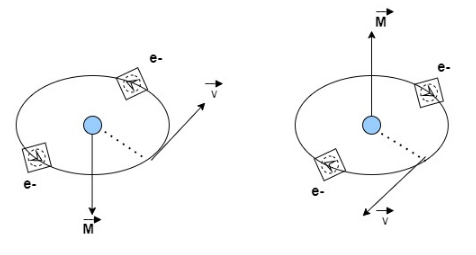
The magnetic moment of a diamagnetic atom is
(A) Much greater than one
(B) One
(C) Between zero and one
(D) Equal to zero
Answer
542.7k+ views
Hint: Atoms which have paired electrons have the magnetic moment zero. Because diamagnetism is the intrinsic property of every material and it is generated due to mutual interaction between the applied magnetic field and orbital motion of electrons.
Complete step by step solution
We know that each electron in an atom is revolving in an orbital around the nucleus. The revolving loop is equivalent to a tiny loop of current. Therefore, it possesses some orbital magnetic moment. \[\overrightarrow{\text{M}}\]
$\overrightarrow{{{\text{M}}_{\text{l}}}}=$current$\times $area of loop
In addition to the orbital motion, every electron is assumed to have a spin motion around its axis. Therefore, magnetic moment is $\overrightarrow{{{\text{M}}_{\text{s}}}}$
The vector sum of $\overrightarrow{{{\text{M}}_{\text{l}}}}$ and$\overrightarrow{{{\text{M}}_{\text{s}}}}$provides the net magnetic moment \[\overrightarrow{\text{M}}\] to the atom.
In diagrammatic material
$\overrightarrow{{{\text{M}}_{\text{l}}}}$and $\overrightarrow{{{\text{M}}_{\text{s}}}}$cancel each other for every atom so that the atom has no net magnetic dipole moment. Therefore, motion of all the electrons in an atom of a diamagnetic material is assured to be reduced to motion of two electrons revolving with same angular velocity in a circular orbit of same radius, but in opposite sense. Hence, the magnetic field of two being equal and opposite, cancel each other (in the absence of any external magnetic field), net magnetic moment is zero.
So the option (D) Equal to zero is the correct answer.

Note
When diamagnetic substances are placed in an external magnetising field, they get feebly magnetised in a direction opposite to the magnetising field. Example: Copper, Lead, Gold, Water, Air, Hydrogen, etc.
Susceptibility of diamagnetic does not change with temperature.
Complete step by step solution
We know that each electron in an atom is revolving in an orbital around the nucleus. The revolving loop is equivalent to a tiny loop of current. Therefore, it possesses some orbital magnetic moment. \[\overrightarrow{\text{M}}\]
$\overrightarrow{{{\text{M}}_{\text{l}}}}=$current$\times $area of loop
In addition to the orbital motion, every electron is assumed to have a spin motion around its axis. Therefore, magnetic moment is $\overrightarrow{{{\text{M}}_{\text{s}}}}$
The vector sum of $\overrightarrow{{{\text{M}}_{\text{l}}}}$ and$\overrightarrow{{{\text{M}}_{\text{s}}}}$provides the net magnetic moment \[\overrightarrow{\text{M}}\] to the atom.
In diagrammatic material
$\overrightarrow{{{\text{M}}_{\text{l}}}}$and $\overrightarrow{{{\text{M}}_{\text{s}}}}$cancel each other for every atom so that the atom has no net magnetic dipole moment. Therefore, motion of all the electrons in an atom of a diamagnetic material is assured to be reduced to motion of two electrons revolving with same angular velocity in a circular orbit of same radius, but in opposite sense. Hence, the magnetic field of two being equal and opposite, cancel each other (in the absence of any external magnetic field), net magnetic moment is zero.
So the option (D) Equal to zero is the correct answer.

Note
When diamagnetic substances are placed in an external magnetising field, they get feebly magnetised in a direction opposite to the magnetising field. Example: Copper, Lead, Gold, Water, Air, Hydrogen, etc.
Susceptibility of diamagnetic does not change with temperature.
Recently Updated Pages
Why are manures considered better than fertilizers class 11 biology CBSE

Find the coordinates of the midpoint of the line segment class 11 maths CBSE

Distinguish between static friction limiting friction class 11 physics CBSE

The Chairman of the constituent Assembly was A Jawaharlal class 11 social science CBSE

The first National Commission on Labour NCL submitted class 11 social science CBSE

Number of all subshell of n + l 7 is A 4 B 5 C 6 D class 11 chemistry CBSE

Trending doubts
Differentiate between an exothermic and an endothermic class 11 chemistry CBSE

10 examples of friction in our daily life

One Metric ton is equal to kg A 10000 B 1000 C 100 class 11 physics CBSE

Difference Between Prokaryotic Cells and Eukaryotic Cells

State the laws of reflection of light

Explain zero factorial class 11 maths CBSE




